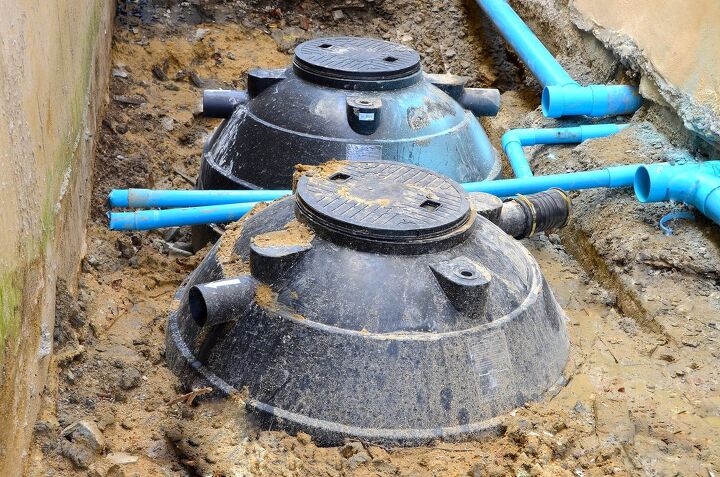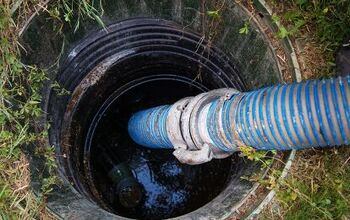Septic Tank Filter Keeps Clogging? (Possible Causes & Fixes)

Your household septic tank is tasked with waste management. Given the amount of waste an average household produces, you can easily imagine how tough the septic tank’s job is. A filter is usually installed to make processing waste a bit more manageable for the septic tank.
Just like the septic tank itself, the effluent filter is routinely exposed to plenty of sewage. It should come as no surprise that it will require cleaning eventually. Still, overly frequent clogging is not the norm for the septic tank filter.
If your septic tank filter clogs frequently, that could be due to excessive water usage or improper waste management. Certain occurrences such as wastewater backing up into your home or flooding near your tank are indicators of a clogged filter. Developing better habits can prevent frequent clogging, but you can also clean the filter on your own if problems arise.
The performance of your septic tank can be significantly affected by the status of its filter. Learn more about taking better care of that septic tank component by continuing with this article.
Do You Need Septic System Repair?
Get free, zero-commitment quotes from pro contractors near you.

What Is the Septic Tank Filter?
Also known as the effluent or outlet filter, the septic tank filter has a very simple, but also very important job. Once it’s in place, the filter’s job is to prevent large particles from entering the septic tank. The filter has holes that are big enough to let wastewater through easily, but the larger particles will be separated.
It’s important to keep the larger particles and the liquid separate. Remember that the septic tank offers a finite amount of space. There’s room there for the scum or the fatty liquids dumped down the drain and the sludge which comprises of solids. The filtered wastewater also remains inside the septic tank for a certain amount of time.
If there is no filter in place, too many large materials can infiltrate the septic tank. Those large items take up plenty of room. Before you know it, they’ve already occupied most of the tank and pumping will become necessary sooner than expected.
Unless you want to pump your septic tank annually, installing a filter is a must. The filter may be an often overlooked component of the septic tank, but its importance cannot be understated.
Why Your Septic Tank Filter Clogs Frequently
Now that we know more about the effluent filter, we can turn our attention to the issues that often affect it. In this article, we’re focusing specifically on clogging. It’s important to note here that the septic tank filter clogging is normal. After some time, cleaning the filter will become necessary.
However, there’s a difference between the typical filter cleaning requirements and extraordinary circumstances brought about by underlying issues. For this section, we’ll focus on the culprits that can cause a filter to get clogged up way earlier than expected.
Excessive Production of Wastewater
The way your household uses water will impact how long the septic tank’s filter can hold up. If you do numerous loads of laundry at home, that can lead to plenty of wastewater being produced. Washing machines are notorious for effluent production and they also produce lint, which the filter has to sort out.
You can also put a strain on the filter during days when you clean up around your home. Heavy cleaning unsurprisingly produces plenty of wastewater.
Homeowners who rely on water filters or softeners may also be placing an additional burden on their effluent filters. Those filtered substances have to go somewhere. Often, the dumping ground for them becomes the septic tank and that means the filter has to work again.
Careless Waste Disposal
The excessive use of water on its own is not going to clog your effluent filter. Other things will contribute to that such as potentially improper waste disposal.
Take a moment to consider how you handle your waste at home. Let’s talk about the waste materials from cooking and eating first. Do you just dump everything in your garbage disposal and expect it to handle the job? Do you separate the excess grease or just let it flow down the drain?
Many of us are guilty of neglecting proper waste management, especially when it comes to discarded food and leftovers. Because they’re not pleasant to handle, we just dump them down the drain and forget about them.
The problem is that those substances don’t magically disappear. We’re just passing them off to the septic tank and the filter. Keep that habit up and the filter may soon struggle to do its job.
It’s not just the food items you have to worry about. Other disposable products used in the bathroom should also not be sent down the drain. The only disposable item you can really get away with flushing is toilet paper.
Use of Harmful Chemicals
Septic tanks host bacteria that are tasked with breaking down the wastewater. Bacteria are living organisms and you could kill them accidentally if you aren’t mindful of what you send down the drain.
Numerous chemicals are capable of eradicating the bacteria inside the septic tank. It would be best to avoid using them near drains if possible. Do note though that some cleaning products are suitable to flush down the drain because they won’t kill the bacteria. Make sure to include them in your shopping list if you want to take better care of your septic tank’s filter.
The Signs That Your Septic Tank’s Filter Is Clogged
A clogged septic tank filter will make its presence felt. You must be able to pick up on the signs hinting at that so you can fix the problem immediately. Let’s go over the clear signs of a clogged filter below.
Unusual Draining
Probably the first sign of trouble you’ll encounter is the emergence of unusual draining. Unusual in this context means that the draining is taking place very slowly. It may even seem at times that the water is not draining at all.
Slower draining is not the only symptom of a clogged filter. You may also sometimes hear gurgling noises coming up from the drain. Those noises are additional signs telling you to take action sooner rather than later.
Wastewater Flowing back into Your Home
A clogged filter can also cause the wastewater to move in an unexpected direction. To be more specific, your blocked filter may cause the effluent to flow back into your home.
There is no understating how unpleasant the sight of effluent backing up into your home can be. It’s a nightmarish sight for many homeowners. Those who want to avoid walking around in puddles of wastewater need to take better care of their tank’s filter.
Malfunctioning Drain Field
Issues affecting your septic system’s drain field could also be related to a clogged filter. Sometimes, the issue could come in the form of wastewater moving slowly outside of the drain field. That’s because the clogged filter has prevented a large amount of wastewater from entering the tank.
A malfunctioning drain field could also lead to wet spots forming all over your yard. You can tell that the wet spots feature wastewater because of the foul odor.
How Do You Maintain a Septic Tank Filter?
Here’s the thing about septic tank filters. They don’t actually require a lot of direct maintenance from homeowners.
Effluent filters are similar to the tanks in the sense that they only need major cleaning every few years or so. You can wait for three years before getting your septic tank’s filter professionally cleaned again. Some filters will even remain in working condition without cleaning for up to five years.
You must do some of the things mentioned earlier if you don’t want the filter to require annual cleaning. You specifically want to avoid wasting water, throwing everything down the drain, and using harsh chemicals. Do those things and you will be able to get the most out of your septic tank’s filter.
If your septic tank’s filter is having issues and you want to address them now, you can do that. Follow the steps below to clean the filter on your own.
Step 1: Prepare Your Cleaning Tools and Safety Gear
You don’t need special equipment for minor filter maintenance. A garden hose should suffice for cleaning. Get a screwdriver and a shovel too as you’ll need them to remove the filter from its position.
Putting on some safety gear is also recommended since you’ll be dealing with sewage. Wear some gloves, a mask, and some goggles to keep yourself protected.
Step 2: Locate the Septic Tank Lid
Look for your septic tank by referring to your property’s site plan. You should be able to spot the lid right away if it’s located on the surface. If the lid isn’t visible right away, you may have to dig for it. Grab the shovel and start moving dirt, but be careful not to strike the lid.
Step 3: Remove the Filter
Open up the septic now and start looking for the outlet baffle or baffle pipe. You’ll be able to recognize it easily because it’s shaped like the letter T. After finding the outlet baffle, you should be able to find the septic tank filter close by. Remove it by hand or use the screwdriver if it’s fastened into place.
Step 4: Clean the Filter
Find a spot where you can clean the filter without splashing anything nearby. You will also want to work near a drain to make cleaning easier.
After finding the right spot, set the filter down and start spraying it with the hose. Maintain control over the water pressure to avoid damaging the filter. Keep going until the filter has been cleared of any gunk and debris.
Step 5: Put the Filter Back in Place
With the filter clean, you can now put it back inside the outlet baffle. Put it back into position and give it a wiggle to ensure that it is secure. After that, you can simply close the septic tank lid and clean up any mess left behind.
Do You Need Septic System Repair?
Get free, zero-commitment quotes from pro contractors near you.

Related Questions
How Can I Address a Clogged Filter before It Presents Issues?
Some of the problems caused by clogged filters can be very troublesome. You certainly don’t want them rearing their ugly heads when you have guests over.To address those matters before they become real problems, you can hire professionals to inspect your septic tank. They can open up the tank and let you know the current condition of the effluent filter. They can also tell you if cleaning the filter is already necessary.Not all homeowners may be keen on the idea of paying for regular inspections though. If you are one of those homeowners, you can purchase a filter monitor instead. That monitor will let you know right away if the filter needs to be cleaned.
How Much Do I Have to Pay to Get the Septic Tank Filter Cleaned?
The good news for homeowners is that filter cleaning is more affordable than septic tank pumping. Filter cleaning may cost as high as $200, but you can also find specialists who will handle that job for $100.Also note that filter cleaning is sometimes bundled together with septic tank pumping. You may be able to get a better deal if you secure a service package such as that.

Gary Evans is passionate about home improvement. He loves finding out how to make improvements in the easiest, most practical, and most affordable ways. Upgrading his home kitchen is one of his ongoing hobbies. Gary is also a long-time content creator and enjoys spending his free time tending to his hydroponic vegetable garden.
More by Gary Evans




















![How To Reset A Whirlpool Cabrio Washer [In 5 Easy Steps!]](https://cdn-fastly.upgradedhome.com/media/2023/07/31/9076531/how-to-reset-a-whirlpool-cabrio-washer-in-5-easy-steps.jpg?size=350x220)






